Description: This perennial plant is a woody vine up to 60' long. It usually climbs up trees, shrubs, or fences, but sometimes sprawls across the ground, forming a ground cover up to 1' tall. The stems are initially green and hairless, but eventually they become brown and woody. The alternate leaves are palmately compound, usually consisting of 5 leaflets (rarely 3 or 7). Each compound leaf has a long slender petiole up to 6-8" long. Individual leaflets are up to 6" long and 2½" across; they are ovate or obovate and coarsely serrated (at least along the upper half of their margins). The upper side of each leaflet is dark green, while the lower side is light green and either glabrous or pubescent. The bottom of each leaflet is often wedge-shaped, while its outer margins may taper abruptly into a short blunt tip, or they may taper gradually into a long pointed tip. Opposite from the leaves, are branched tendrils that often terminate into flattened pads. These pads can cling to tree bark, wooden fences, brick walls, and other rough surfaces. During the fall, the foliage becomes colorful, varying from burgundy to brilliant scarlet.
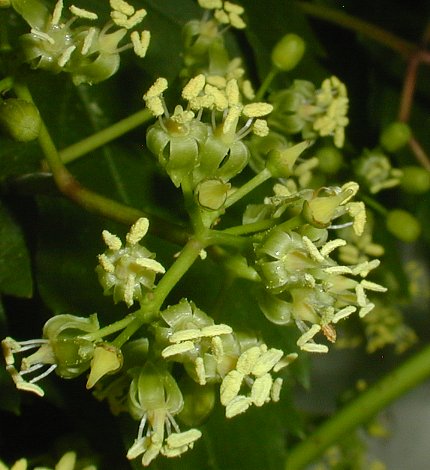
Occasionally, panicles of yellowish green flowers are produced. These panicles are usually broader than they are long. Each flower is about ¼" (6 mm.) across, consisting of 5 green petals, 5 stamens, and a pistil with a stout style. The sepals are insignificant or absent. The petals are triangular-shaped and curve backward. The stamens have white filaments with large yellow anthers. On each plant, the flowers may be perfect, staminate only, pistillate only, or both staminate and pistillate. The blooming period occurs during early to mid-summer and lasts about 2-3 weeks. Each flower is replaced by a fleshy berry about 1/3" (8 mm.) across that contains 2-3 seeds. Each berry is initially green, but it becomes blue-violet during the autumn. Similarly, the peduncles and pedicels of the flowers/berries are initially green, but they eventually become bright orange-red or red during the autumn. The root system is woody.
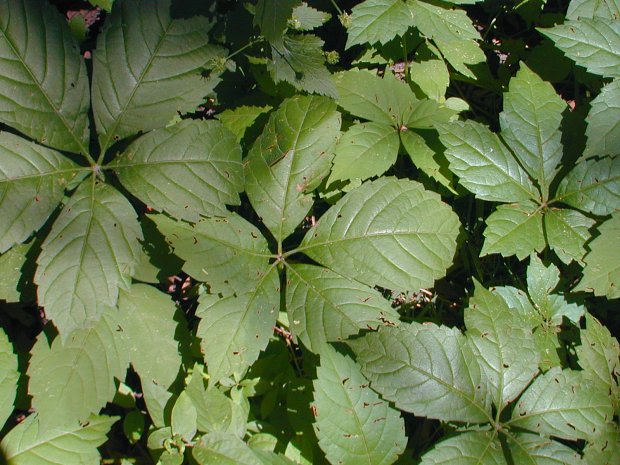
Cultivation: The preference is partial sun, moist to slightly dry conditions, and a soil containing loam or clay-loam. Virginia Creeper also adapts well to gravelly or rocky soil, and it tolerates full sun or light shade. This woody vine is a robust grower and requires plenty of room.
Range & Habitat: The native Virginia Creeper occurs in every county of Illinois, where it is quite common (see Distribution Map). Habitats include deciduous woodlands, woodland borders, thickets, gravelly seeps, limestone glades, rocky bluffs, fence rows, abandoned or little-used railroads, and walls of buildings. It can adapt to disturbed habitats in both rural and urban areas.
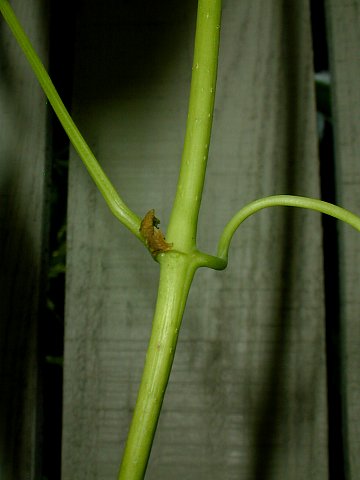
Faunal Associations: The nectar and pollen of the flowers occasionally attract various bees, including cuckoo bees (Coelioxys spp.), leaf-cutter bees (Megachile spp.), Halictid bees (Lasioglossum spp., Augochlora pura), and a resin bee (Heriades carinata); see Robertson (1929), Discover Life (accessed 2015), Wilhelm & Rericha (2017), and Krombein et al. (1979). Other insects feed destructively on the leaves, plant sap, wood, and other parts of Virginia Creeper. These insects include larvae of the Woodbine Borer (Saperda puncticollis), leaf beetles, adult scarab beetles, larvae of leaf-mining flies, stink bugs, Virginia Creeper Aphid (Aphis folsomii), leafhoppers, armored scales, larvae of the Woodbine Seed Wasp (Prodecatoma cooki), larvae of moths (especially Sphinx moths), and oligophagous thrips (Liothrips russelli). Leaf-cutter bees (Megachile spp.) sometimes cut the leaves to use as material in their nests. The Insect Table provides more complete information about these insect feeders.
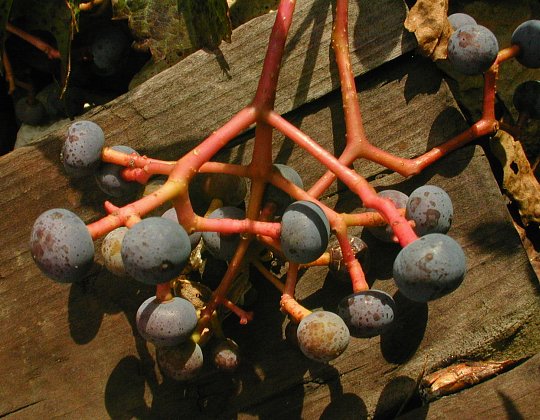
Photographic Location: The photographs were taken of woody vines growing along a fence row, a shady yard, and a little-used railroad in Champaign-Urbana, Illinois.
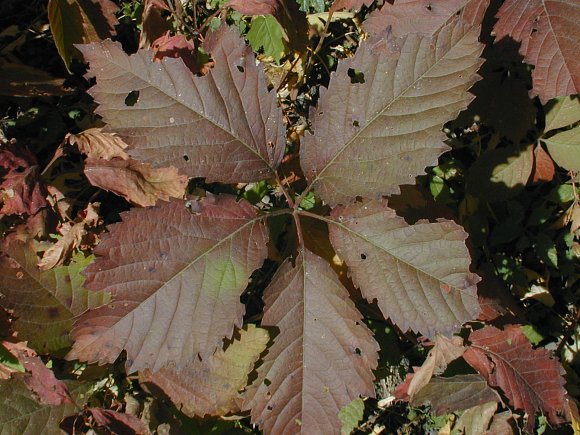
Comments: Virginia Creeper has colorful foliage and berries during the fall. It is more ordinary in appearance during the summer and its flowers are not very showy. The foliage of this woody vine can be rather variable in appearance; some vines produce rather broad leaflets with blunt tips, while others produce more slender leaflets with long tips. Similarly, the lower surface of the leaflets can be glabrous or pubescent, depending on the local ecotype and growing conditions. The palmate compound leaves (consisting of 5 leaflets) are quite distinctive, which makes Virginia Creeper easy to identify in the field. However, there is one exception: A closely related species, Parthenocissus inserta (Woodbine), also has palmate compound leaves and is very similar in appearance. This latter species is confined primarily to northern Illinois. Woodbine differs from Virginia Creeper primarily by its tendrils, which lack flattened pads that can cling to rough surfaces. Instead, the tendrils of Woodbine twine about narrow objects in the conventional manner. Sometimes Virginia Creeper is confused with Toxicodendron radicans (Poison Ivy, Poison Oak), but this latter species has trifoliate compound leaves and dull white berries.